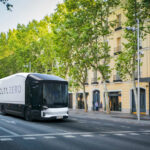Busworld is back!
Busworld is back!
Busworld Europe has made a triumphant return! The world’s premier exhibition for the bus and coach industry roared back into action for the 26th time from 7 to 12 October, following a four-year hiatus. The event drew a record-breaking crowd to Brussels, Belgium, and there was much for them to see…
This year’s Busworld Europe proved to be a monumental success, covering an impressive 75,000m2 of exhibition space. The 40,120 visitors from 111 countries were kept on their toes, thanks to the 7.8km of corridors in between the stands!
One of the most remarkable aspects of the exhibition was the impressive lineup of exhibitors. The exhibition featured 75 bus and coach manufacturers – a significant increase from the 66 presented in the 2019 edition. In total, 526 exhibitors from 38 countries showcased their innovations, including a remarkable 182 newcomers. The most prevalent countries were Turkey with 96 companies, Germany with 79 companies, and China with 61 companies.
Inside the exhibition halls, a total of 222 vehicles were on display, showcasing the latest advancements in bus and coach technology. Additionally, 29 vehicles were positioned outside for demonstrations, offering visitors a hands-on experience with the latest models and features.
MAN announces upgrade of entire bus and coach range
One of the biggest stories to emerge from Busworld this year was the upgrade of MAN’s entire bus and coach range. The company is introducing a raft of changes, including a brand new electrics/electronics platform with higher performance, new brake and air suspension systems with even more functions, and updates to the MAN D26 coach engines and the topography-dependent EfficientCruise gearshift programme. However, the new digital cockpits and extended range of assistance systems impressed us most, so we’ll focus on those.
The new digital cockpits are utterly fabulous! One of the most significant features is the SmartSelect control unit in the middle of the console, in combination with a high-quality MMC Advanced infotainment system with navigation (standard in the NEOPLAN Skyliner). We have long known and loved SmartSelect, having first experienced it on MAN trucks. Honestly, it makes touchscreens seem redundant, because it’s so much safer. With touchscreens, you always need to take your eyes off the road, but with SmartSelect drivers can keep their attention on the road at all times.
The intelligent SmartSelect control unit comprises three main elements. The first is a bottom, larger ring that is used to navigate on the menu level. Above this is the smaller rotary pushbutton control, which can be used to select individual menus and functions. For better visibility at night, both rings are illuminated all the way around. The highlight is the top touchpad that allows alphanumeric characters to be input for functions such as navigation. The system – which sounds complicated but really isn’t – is a major innovation in the bus segment and is otherwise found only in premium cars. We reckon it rocks.
Another highlight of the new cockpit is the 12-inch colour digital display, which offers a full screen view with large icons in 3D. The detailed home screen view has selectable alternative displays on the right and left next to the central display. When the information positioned at the sides is selected, the two side menus move from the outside to the inside like curtains entering the driver’s central field of vision. In this way, different information can be displayed in parallel for optimal driver perception. If an event occurs, this is moved into the foreground and cannot be overlooked. Like SmartSelect, the digital display is easier to use, while it’s also super clear.
Yet another highlight is the new MMC Advanced infotainment system, which is standard in MAN and NEOPLAN coaches and is offered as an option for the MAN Lion’s Intercity. The system has been newly designed for bus use and is operated by SmartSelect in combination with a seven-inch monitor. It can be operated using the multifunction steering wheel, the proprietary MAN voice control system, or via a key control panel in any intercity buses and coaches that don’t have the MMC with navigation.
Here too, there is no touch function (and that’s quite intentional). While the vehicle and assistance system functions are called up via the multifunction steering wheel or the left drop arm and shown in the fully digital 12-inch driver’s display, media functions are displayed on a separate seven-inch media display with independent control elements in the form of classic control panels (with or without the MAN SmartSelect control unit). This distinct separation and the logically grouped arrangement of the functional units combine to create maximum clarity, significantly reducing distractions while driving and accidental operating errors.
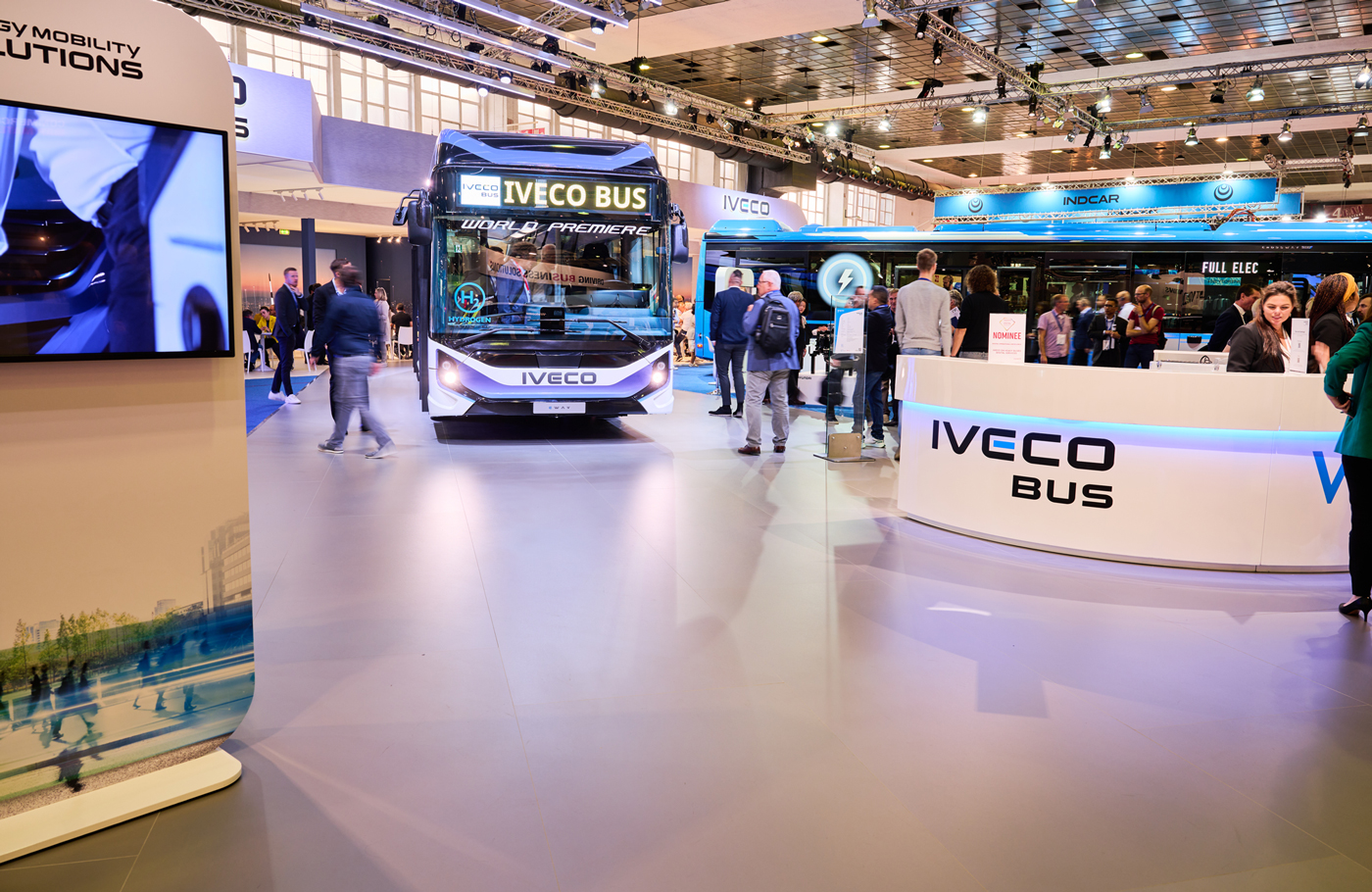


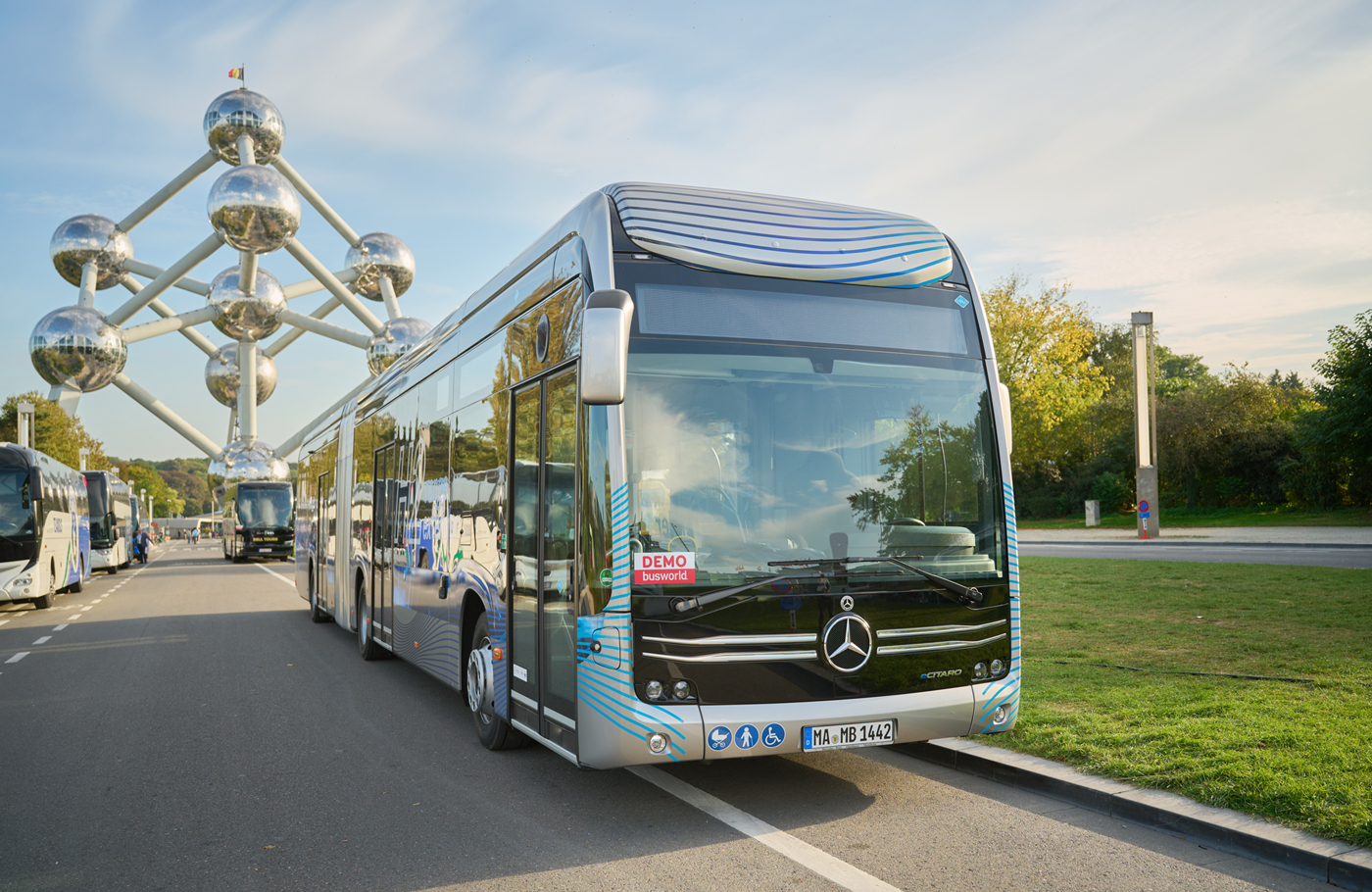

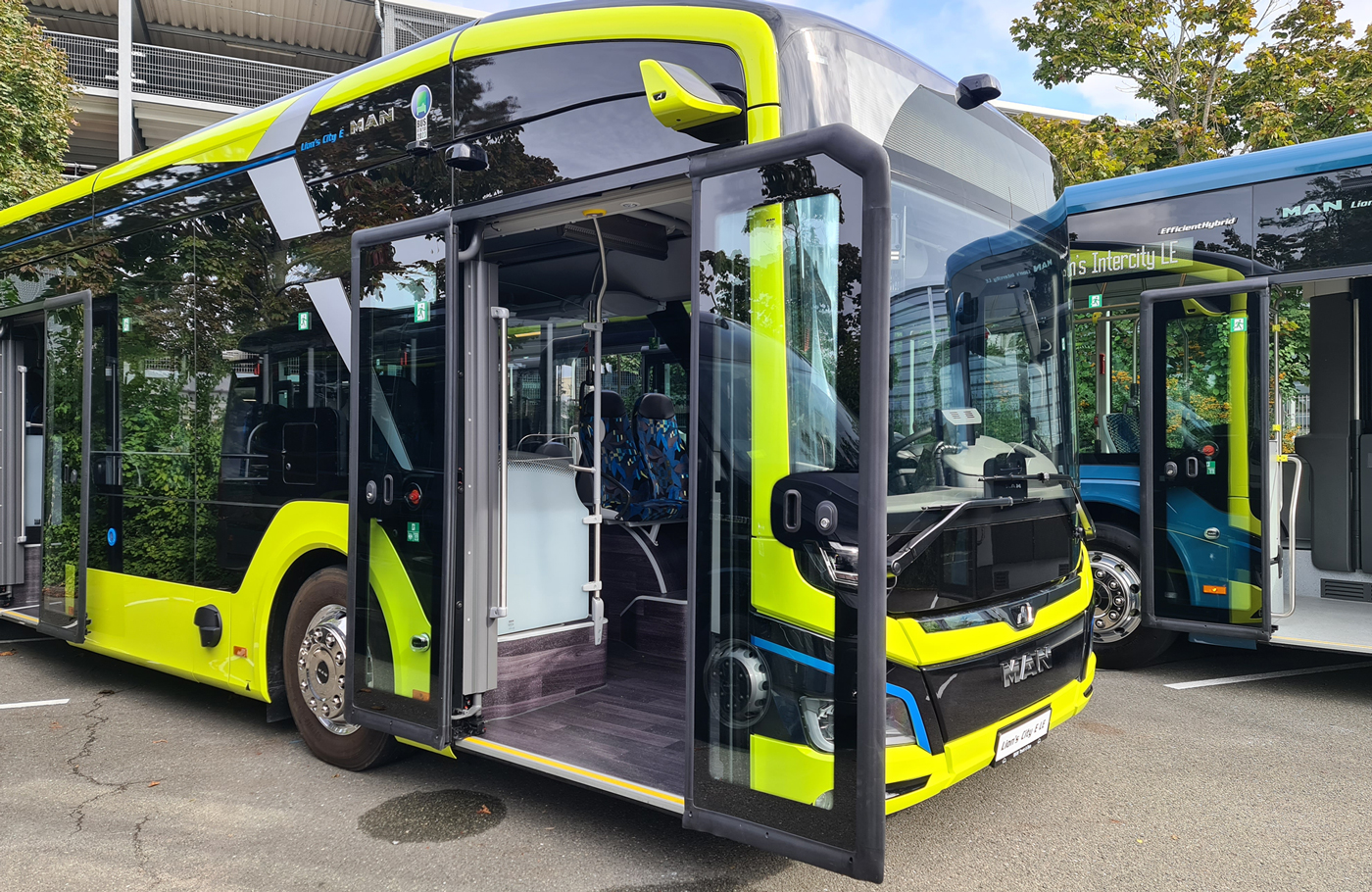
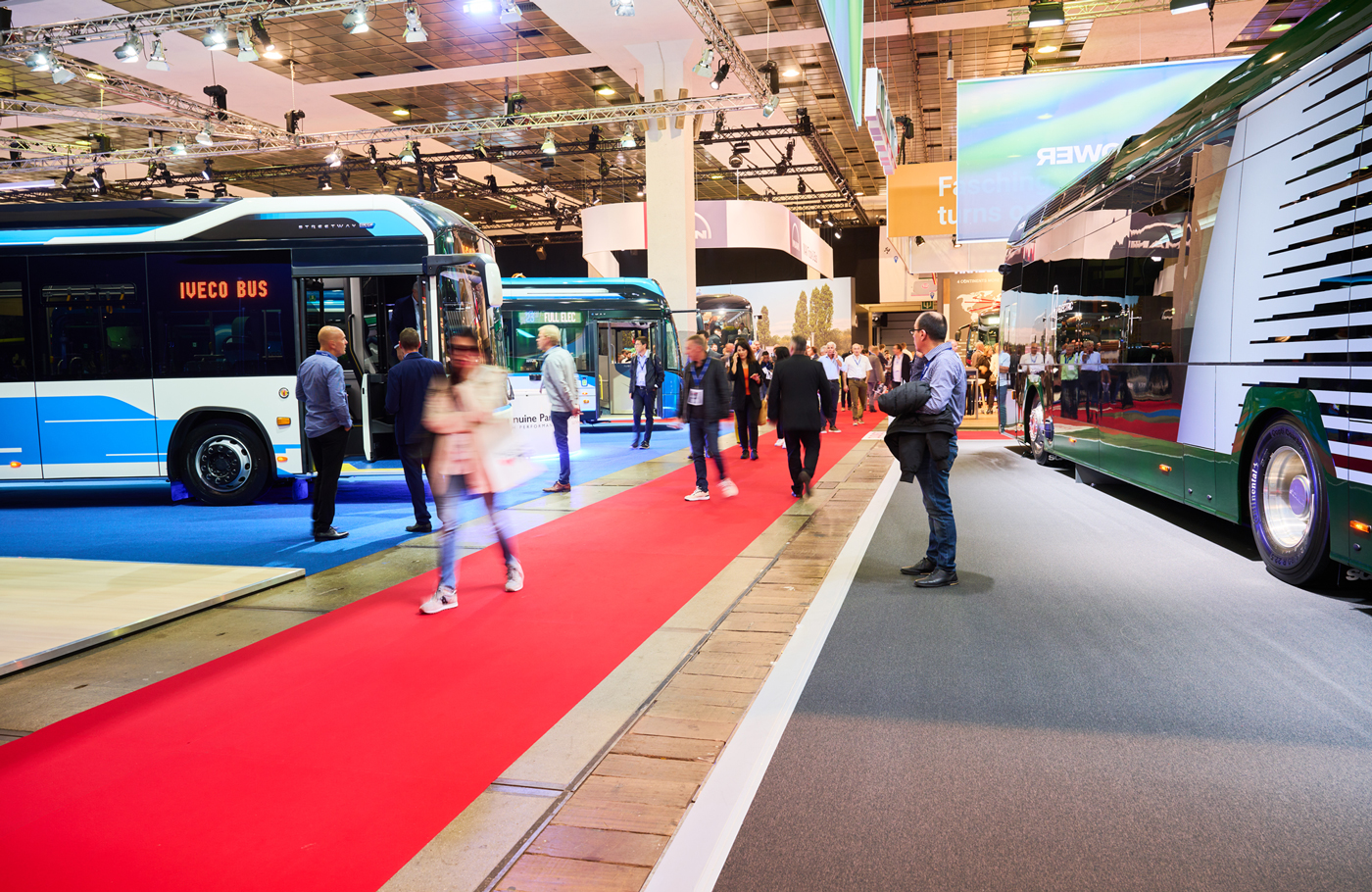
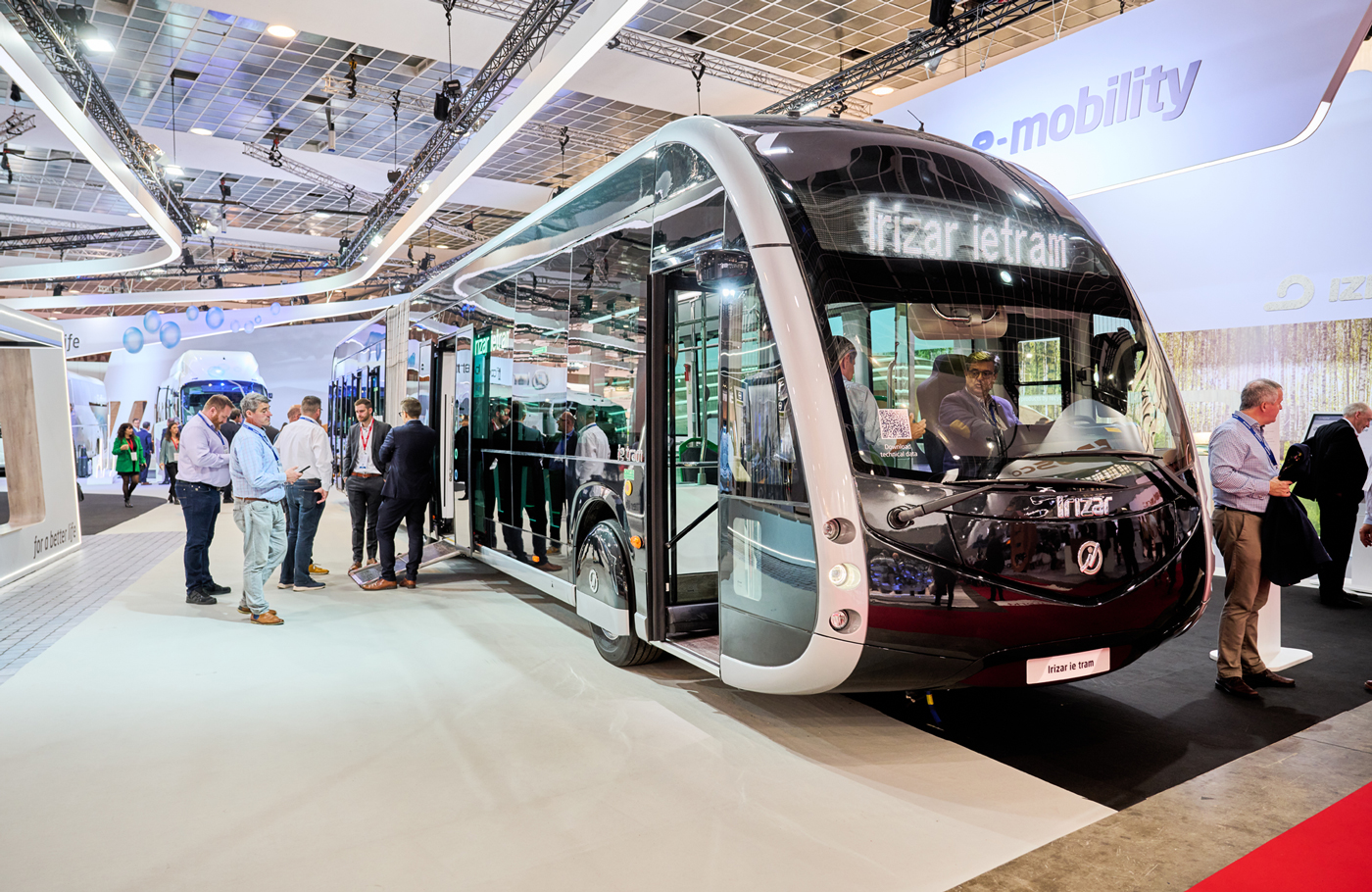

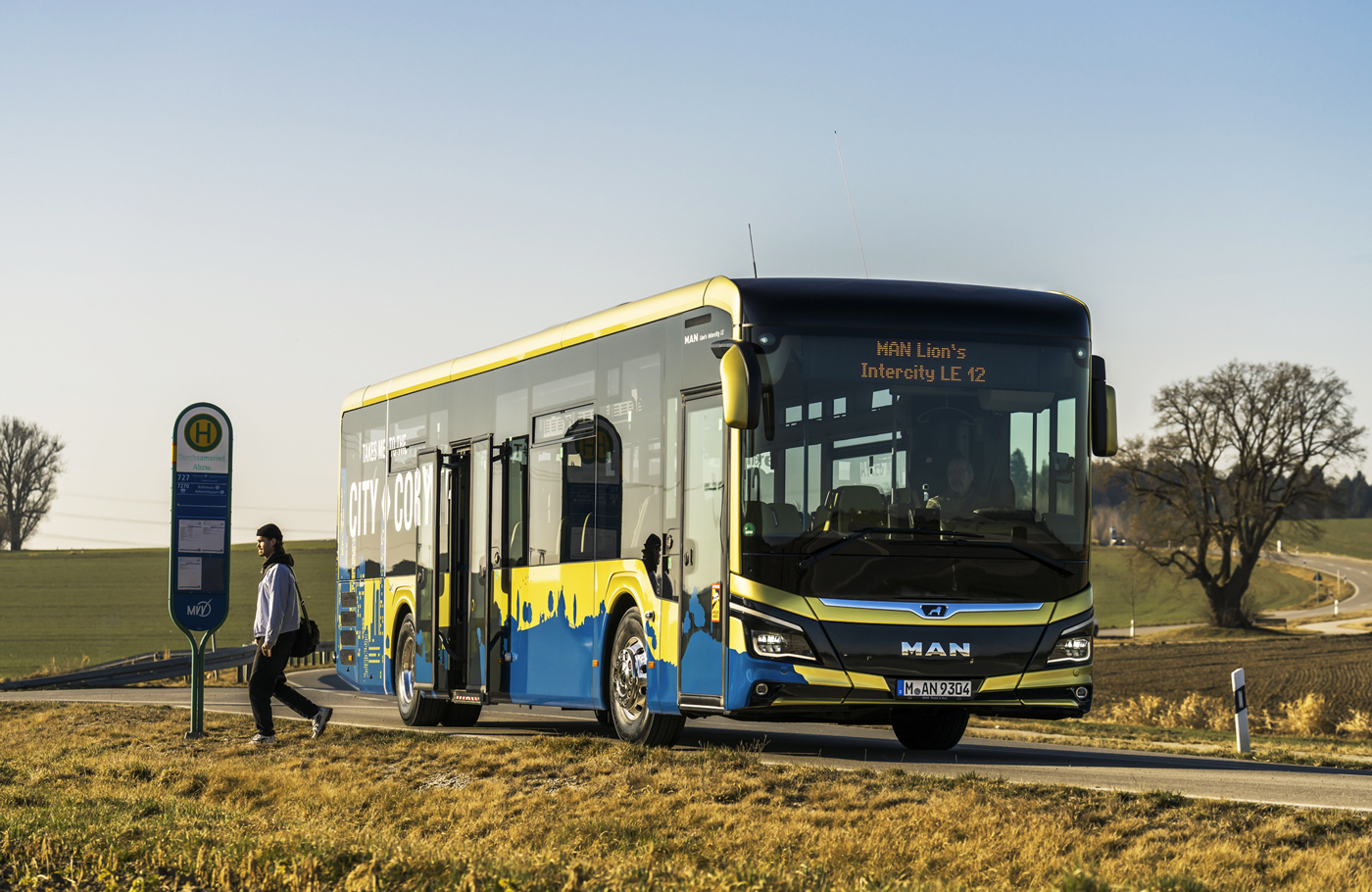

Another innovation that’s definitely worth a mention is the new multifunction steering wheel, which is seamlessly integrated into the human-machine interface (HMI) concept. The new MAN multifunction steering wheel allows drivers to perform all their tasks conveniently and safely. With its ergonomically varying rim diameter, the steering wheel is comfortable to hold and can be operated very easily and safely. The multifunction steering wheel makes it easier for drivers to control all functions without having to take their hands off the steering wheel, and is also being offered as an option for the city buses and intercity models for the first time.
Something else that will resonate with drivers and passengers as summer approaches is the newly designed climate control centre, which features across the model range. It works much like car aircons, with clearly marked and easy-to-use buttons and rotary controls. The fact that the settings can be recognised quickly and without any distractions is obviously a good thing for road safety.
While we’re on the subject of safety, it’s great to see MAN roll out a full house of new and extended assistance and safety systems. The star of the safety show is definitely the radar-supported turn assist system (for the right side of the bus that is hard for the driver to see), which is automatically activated at speeds below 30km/h.
The system consists of a unit with two radar heads behind the right front wheel that together have a coverage angle of almost 180 degrees and therefore cover the whole side of the vehicle. Radar sensors have proven themselves to be more reliable than camera-based systems such as the familiar active-warning turn assist system, particularly in very poor visibility conditions. The new turn assist system thus offers even more safety and also reduces the strain on the driver more than ever before.
There are also some updates to the drivers’ old favourite assistance system, Adaptive Cruise Control (ACC). In a recent new development, the system can now brake to a standstill with its additional Stop & Go function and then move off automatically without any driver intervention within a short period of two seconds.
These two systems are combined with the electrical MAN Comfort Steering system to produce a Traffic Jam Assist system that not only takes over responsibility for maintaining the distance to the vehicle in front in stressful queue situations, but also performs the necessary steering corrections. This means that up to speeds of 60km/h, drivers can enjoy their first taste of automated driving and relax while this system does the work. How cool is that?
World debut from Iveco
Iveco Bus exhibited its extensive offering of full electric vehicles: a complete electromobility range capable of meeting the requirements of every mission, from city and intercity buses (E-Way, Streetway ELEC, and Crossway LE ELEC) to minibuses (eDAILY).
This carbon-free range will be extended with the new E-Way H2 hydrogen-powered city bus, which is equipped with a fuel cell system from HTWO, Hyundai Motor Group’s fuel cell system-based hydrogen business brand. The vehicle made its world premiere at Busworld.
The E-Way H2 is a 12m-long low-floor city bus equipped with a 310-kW e-motor and an advanced fuel cell system. With four tanks offering combined hydrogen storage of 7.8kg and one 69-kWh battery pack by FPT Industrial, the vehicle offers a driving range of 450km under normal operating conditions.
The bus allows for both hydrogen refuelling and plug-in battery charging. Developed by Iveco Bus, this hybrid mid-power concept not only optimises vehicle charging, but also helps the on-board battery pack and fuel cell system to achieve their highest efficiency and durability.
“Hyundai has been a pioneer and leader in hydrogen technology for 25 years and is the field-proven leader of hydrogen fuel cell mobility and commercial transport globally. We firmly believe this energy source is one of the fundamental pillars for achieving a sustainable society and we are delighted to share this vision with our partner Iveco Group,” said Ken Ramirez, executive vice president and head of global commercial vehicle & hydrogen business at Hyundai Motor Company, at the reveal of the bus. “Today’s unveiling reflects another concrete example of our strong partnership and commitment to accelerate the industry’s net-zero transformation and deliver our mission of progress for humanity.”
“We are proud to present our hydrogen-powered E-Way H2,” added Domenico Nucera, president of Iveco Group’s bus business unit. “This exciting milestone on our sustainability journey is an outcome of our successful collaboration with Hyundai Motor Company and shows that by combining our strengths, we can foster a people transportation system that is environmentally friendly, helps to fight climate change, and creates a healthier future for generations to come.”
The E-Way H2 will be produced in the Iveco Bus plants in Annonay, France, and Foggia, Italy.
ERGONOMICS ON BUSWORLD AGENDA
UK steering system manufacturer Pailton Engineering exhibited at Busworld in Brussels from 7 to 12 October. The company showed two of its newest steering columns: the electric column and the tilting head column. Both offer the latest in ergonomic design.
The fourth prototype of Pailton’s electric steering column has been readied for action and was shown in a demonstration bus. This pioneering technology, the first of its kind in the bus and coach sector, is designed to improve ergonomics and working conditions for bus drivers. It has been developed in partnership with Continental and Isri.
Pailton also showed the tilting head steering column designed for the current range of VDL Citea buses. Much like the electric column, ergonomic considerations are at the forefront of its design. The unique tilting head mechanism allows the column to conform with the industry standard in all European Union member states, making it the only product of its kind to offer this level of adjustability.
The Pailton team was on hand to talk to visitors about the full range of steering products on offer. As well as steering columns, the Midlands manufacturer produces a range of steering parts and can design complete steering systems. As a mid-volume manufacturer, the company has grown its reputation through custom-engineering and design flexibility.
“It feels like a long time since the last Busworld in 2019,” says Roger Brereton, head of sales at Pailton Engineering. “The show has always been a major highlight in our calendar and missing out during the pandemic was frustrating. As you can imagine, we were thrilled to come back after four years away.’’
The unveiling of the latest electric column was a major attraction at Busworld. ‘‘Electric columns are common in the automotive sector, but our focus is on using this technology for the benefit of the driver, reducing musculoskeletal injuries and improving conditions so that driver retention can be increased, and costs associated with absence and injury can be reduced,’’ Brereton adds. ‘‘It’s about raising awareness of the issues and changing mindsets.’’
The latest version builds upon the industry feedback Pailton received at Busworld in 2019. ‘‘We’ve reduced the packaging size of the column since last time,’’ explains Suraj Jandu, lead project engineer. ‘‘But the biggest challenge has been ensuring the motors were able to operate with the column and the additional weight of the dashboard.’’
Scania launches battery-electric bus platform
The new Scania battery-electric bus platform – one part of the company’s complete e-mobility solutions covering vehicles, services, and systems – made its debut at Busworld this year. With the introduction of low-entry 4×2 buses, the sustainably sourced and built batteries offer a vast energy storage capacity of up to 520kWh and have been developed specifically for heavy commercial vehicles, enabling a range of over 500km in optimal conditions.
Scania’s committed electrification journey started with field tests of hybrid electric buses as early as 2007. Today, with the introduction of the new Scania battery-electric bus platform and complementary e-mobility solutions, Scania advances along its electrification roadmap to reach the set Science-Based Targets for CO2 reduction and to provide silent zero emission transport for people and societies around the world.
Scania´s e-mobility offering encompasses everything from site energy and operational analysis to charging units, financing, installation, and a range of other services, providing guidance throughout the implementation process and enabling reliable and efficient operations.
The initial introduction of the new platform is made available in low-entry 4×2 buses which will be developed in close collaboration with bodybuilder partners. These buses will be available in two performance steps: a four-battery variant with an installed capacity of 416kWh and a five-battery variant with an installed capacity of 520kWh. In optimal conditions, this equates to ranges of over 400 and 500km respectively.
Daimler shows eCitaro fuel cell
The premiere of the eCitaro fuel cell 12-m solo bus took place on Daimler’s Busworld stand. The vehicle’s fuel cell is supplied by Toyota, with the heavy-duty unit generating a maximum output of 60kW. In the eCitaro fuel cell bus it operates very efficiently at its best operating point of around 20 to 30kW and within a voltage range of 400 to 750V, resulting in a comparatively low consumption of hydrogen for power generation. The very long service life of around 40,000 hours when used as a range extender is also remarkable.
The eCitaro fuel cell uses the latest generation of high-performance batteries. These NMC3 lithium-ion batteries (NMC stands for nickel-manganese-cobalt-oxide) have a very high energy content and are very durable.
Similar to the hydrogen tanks, the batteries are scalable. There are three battery packs with a total capacity of 294kWh in the solo bus, while the articulated bus has either three or four battery packs with a maximum energy capacity of 392kWh. These battery configurations already ensure a considerable range.
Both the battery capacity and amount of hydrogen carried can be configured individually, so each transport operator is provided with an eCitaro fuel cell bus tailored to its individual deployment profile. As a result of the long range, charging is consistently carried out using a plug at the depot with a maximum charging power of 150kW.
Busworld Europe 2025 will be hosted at the Brussels Expo from 4 to 9 October. We will be there, and we hope you will join us!
Digital Awards presented for the first time
In keeping with the importance of digital solutions within the bus and coach industry, Busworld organised and awarded Digital Awards for the first time at this year’s fair. This took place during the Digital Mobility Solutions Conference – another first at Busworld. The Digital Awards were divided into four different categories:
Digital On-Board Comfort Award – won by MAN Truck & Bus
This comprises everything that makes the journey more enjoyable and comfortable for drivers and passengers, from new entertainment systems to human-machine interface (HMI) solutions.
The winner was MAN Truck & Bus for its new Digital Cockpit with SmartSelect – a clear step into the HMI future. With its innovative SmartSelect operation and the full integration of the new electric platform and the latest ADAS systems, the Digital Cockpit helps the driver to concentrate on their job without being distracted.
Digital Operational Excellence Award – won by Iveco Bus
Digital operational excellence allows operators to manage their fleets in a way that combines efficiency and sustainability with telematics and other systems.
The winner of this category was Iveco Bus with its IVECO ON Heavy Buses Digital Services solution. IVECO ON Digital Services for heavy buses meets the needs of most public transport authorities and operators in terms of proactive maintenance and downtime reduction, with specialised key performance indicators and trends available on online reports, as well as remote diagnosis and programming. Protection against cyberattacks is another focus of the system. Multi-brand data management is possible with the agnostic telematics system. Combined with the integration of third-party apps, this was the biggest reason to vote for this all-encompassing telematics system.
Digitally Enhanced Driving Award – won by Karsan
This category is all about partially and fully autonomous vehicles, as well as the various required sub-technologies and tools.
The winner was Karsan with its autonomous e-ATAK. The Turkish OEM has developed and produced the world’s first SAE Level 4 serial production autonomous bus. Together with renowned software partner ADASTEC, Karsan developed and implemented the software of the autonomous vehicle. The fully homologated midibus has been in operation since 2021 in the US and since 2022 in the EU (Norway). It was also available for test drives at Busworld Europe.
E-Mobility Management Award – won by ChargePoint/TWAICE
Modern e-mobility is no longer about vehicles alone, but about the entire systems required to operate and charge a fleet of buses cheaply and efficiently.
The winner of the e-mobility category was the ChargePoint/TWAICE Battery Health Package. As leaders in their fields of expertise, ChargePoint and TWAICE teamed up to combine their unique strengths and bring to market the world’s first battery analytics solution that is seamlessly integrated in fleet management software, independent of single OEMs.
TWAICE brought its expertise in battery analytics, building on top of ChargePoint’s Data Hub and jointly integrating it into the ChargePoint system for maximum customer value.
Published by
Focus on Transport
focusmagsa






